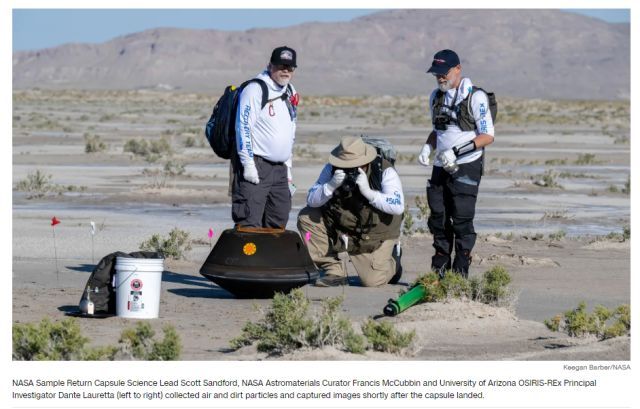Today, OSIRIS-Rex (Origins, Spectral Interpretation, Resource Identification, and Security–Regolith Explorer) came back and delivered that sample:
More info here.
This is the only part of OSIRIS-Rex that made it back to Earth: the Sample Return Capsule:

The SRC’s structure consists of a graphite-epoxy material covered with a Thermal Protection System making use of NASA’s PICA (Phenolic-Impregnated Carbon Ablator) heat shield technology.
PICA is a lightweight material designed to withstand high temperatures and mechanical stress. The technology was developed at NASA’s Ames Research Center. Interstingly, SpaceX modified the PICA technology for its Dragon and Dragon 2 spacecraft, enabling the re-use of heat shields.
The principle behind ablative heat shield technology is that a boundary layer is created between the shield’s outer wall and the extremely hot shock layer gas by allowing the heat shield material to slowly burn away and, in the process, generate gaseous reaction products that flow out of the heat shield, keeping the shock layer at a separation distanceand reducing the overall heat flux experienced by the outer shell of the spacecraft.
The processes occurring at the heat shield material include a charring, melting and sublimation on the one hand and pyrolysis on the other.
Pyrolysis creates the product gases that are blowing outward and create the desired blockage of convective and catalytic heat flux. Radiative heat flux is reduced by introducing carbon compounds into the boundary layer gas which make it optically opaque.
There's charring indeed, that's for sure:

For the next two years, about 30% of the sample will be analyzed at a dedicated clean room inside Johnson Space Center as well as in labs around the globe, including OSIRIS-REx mission partners at the Canadian Space Agency and Japanese Aerospace Exploration Agency (the latter of which has already an asteroid sample, obtained from Asteroid Ryugu by its Hayabusa 2 mission, which came back with it in 2020). About 70% of the Bennu sample will remain in storage, anticipating the arrival of better technology to investigate it.
MFBB.